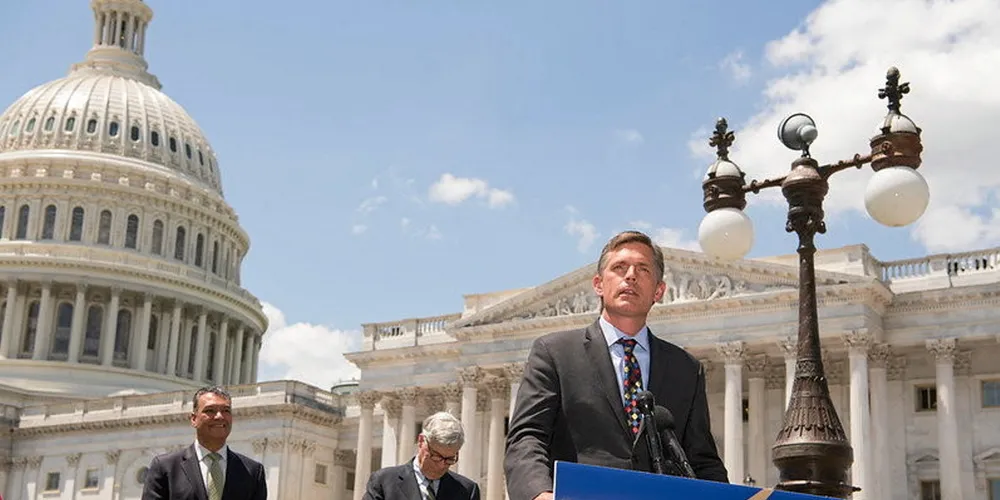'No endlessly patient capital': US must speed transmission or green shift will fail, senator warns
New Mexico Democrat Martin Heinrich says America must make permitting more timely as flagship SunZia project takes years

The US must make construction and upgrades of electric transmission and distribution infrastructure a national priority and central piece of its overall strategy to successfully address climate change, according to Senator Martin Heinrich, who is helping lead permitting reform efforts in Congress.
“Building big things in America again is the key to building our clean energy future,” he told an American Council on Renewable Energy conference on Thursday, adding, “We are not looking to reduce the scope of our ambitions.”
Among the headline US climate goals for 2030 are a 50-52% reduction in greenhouse gas emissions from 2005 levels, 30GW offshore wind, and electric vehicles comprising half of new automobile and light truck sales. And by 2035, a carbon-free electric grid.
Transmission gap
Meeting those demanding targets will require a major push toward electrifying the world’s largest economy. To expand its high-voltage system 60% the balance of this decade, the US will need to invest $350bn in transmission, according to a late 2020 study led by Princeton University.
Some experts believe achieving a net-zero national economy by 2050 may require addition of several terawatts of energy storage and emissions-free generation resource, plus double or triple the country’s present 600,000 miles (965,606 km) of transmission lines.
By comparison, the US last year added 675 miles of lines with 230kV voltage or above and had only 3,845 miles with a possibility of completion through May 2025.
At the end of 2022, the US had roughly 227.4GW of battery storage, utility solar, and wind capacity in operation. Last August’s landmark federal climate law will turbocharge existing strong market demand for clean energy over the next decade with about $230bn in tax credits.
Impatient capital
Heinrich, a New Mexico Democrat, cited the SunZia project – a 3GW, 550-mile high-voltage direct current (HVDC) wind power line from his state to neighbouring Arizona – as a poster child of how lengthy permitting processes are hurting the country’s ability to achieve climate goals.
“Future transmission projects simply cannot take a decade and a half. There is no such thing as endlessly patient capital,” he said. “We know we are going to need to invest in many, many more transmission lines like this to meet our nation’s full potential as a global leader in the clean energy transition.”
Last month, the federal Bureau of Land Management released a final environmental impact statement for SunZia and will issue a record of decision on the proposed right-of-way this spring. Heinrich said he is confident the project will now advance to construction.
These are a transmission facilitation initiative, a new revolving fund at the Department of Energy (DoE) that will help developers overcome financial hurdles to build new lines or upgrade existing ones; $760m to help site and permit interstate and offshore wind lines, and increased DoE loan programme funding capacity for line upgrades.
Still, he acknowledged that while helpful, much more will need to be done to match transmission supply and future clean energy demand.
Permitting reform
“We all know we have to go a lot further. That means addressing the underlying problem that finance timelines and the time it takes to get these major infrastructure projects through complex permitting processes simply don’t match up,” he said.
The permitting challenge will require better partnership among federal agencies with applicable jurisdiction, improved engagement between transmission developers and stakeholders along proposed routes, and reform legislation from Congress, according to Heinrich.
He claimed the first is largely in place although execution must improve. The Fixing America’s Surface Transportation Act (FAST) of 2015, Title 41, created new coordination and oversight procedures for infrastructure projects being reviewed by federal agencies, and a new council to enforce them.
Heinrich claims once SunZia became a FAST-41 project, cooperating agencies agreed to and met updated timelines. There are now nine other transmission projects covered under Fast-41 in development stages.
The infrastructure law also reestablished One Federal Decision, which aims to streamline and expedite federal environmental review processes under the 1970 National Environmental Protection Act (NEPA). This requires agencies to cooperate, concurrent review processes, and creation of a “permitting timetable” with a fixed deadline.
In the spring, Heinrich intends to introduce a permitting reform bill to give DoE and Federal Energy Regulatory Commission additional authorities to expedite siting and permitting review process for qualified high-voltage power lines.
A broader bill that has clean energy industry support would revise and update NEPA language as part of federal permitting reform for all energy infrastructure projects could win bipartisan support in a divided Congress. Republicans control the House of Representatives.
The road ahead
Heinrich has two other bills in the works. The first would improve effectiveness of the existing inter-regional planning process for transmission and ensure cost allocation methodologies reflect the multiple benefits provided by inter-regional solutions.
To help ease the cost of paying for new power lines, the second bill would create a federal investment tax credit worth 30% of capital investment.
“I’m convinced the same types of incentives that have fueled the monumental growth in our domestic wind and solar industries over the last decade can prove effective in promoting construction of the transmission we all know we need,” he said.
(Copyright)